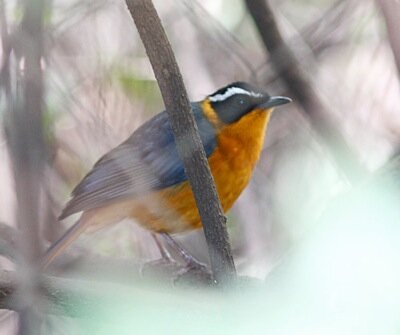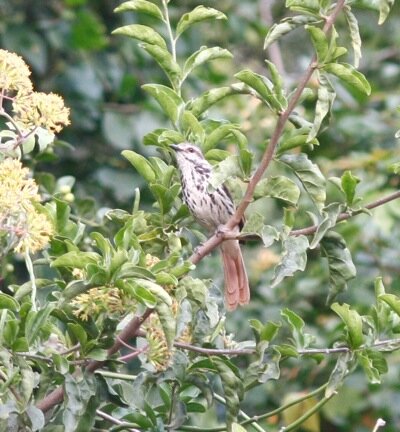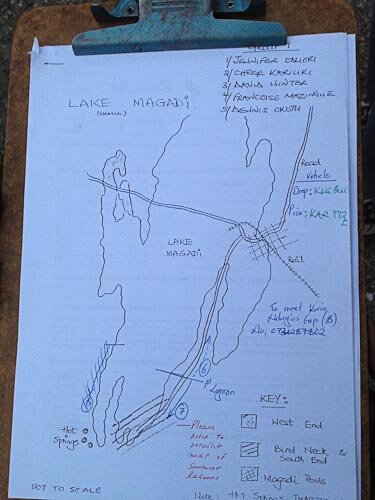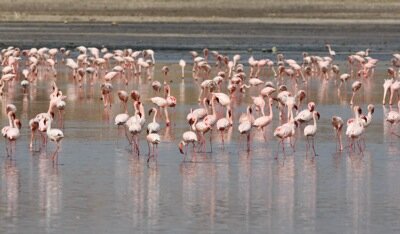A business trip to East Africa last year had me thinking about what birding opportunities I could capitalise on over the two weekends I was in the region. My first stop in Dar es Salaam was rather birdless, apart from a Dimorphic Egret sighting in the traffic one morning and literally 1000s of House Crows. The number of crows in Dar, and the lack of any other passerines, highlighted the importance to me of eradicating the few House Crows we have in Cape Town.

Lake Magadi Map [adapted from Google Earth]
The birding in Nairobi was far more fruitful. I stayed at the leafy Fairview Hotel, which allowed me to catch-up with some common Nairobi garden birds. Baglafecht’s Weaver, Montane White-eye and Ruppell’s Robin-chat were common visitors to the verdant garden setting of the Fairview.

Montane White-eye

Baglafecht’s Weaver

Ruppell’s Robin-chat
As I was going to spend a weekend in Kenya I decided to contact the local birding-pal network to see if a Kenyan birder could give me some local gen. As luck would have it I contacted John Musina from the Department of Ornithology at the National Museum of Kenya and he responded almost immediately saying that I was welcome to join him and his team for the Lake Magadi birding count that weekend. What a luck! Not only was I welcome to join them, but all I had to do was get myself to the National Museum on Saturday and all other logistics would be arranged by the museum. It sounded too good to be true, but by midday on Saturday I was pottering around the National Museum’s garden notching up a few species for my trip list while I waited for our departure. The museum gardens are not a bad place to go birding, and I believe they run bird walks around the leafy grounds every Wednesday morning. In my short wait I managed to notch up Speckled Mousebird (rather a different beast to our southern variety), Cinnamon-chested Bee-eater and Streaky Seed-eater.

Speckled Mousebird

Streaky Seed-eater
Kenya is making a concerted effort to sort out its road infrastructure, and this is very evident when traveling around Nairobi as each major intersection seems to be sporting a construction team of sorts. However, call me a cynic, but give Kenyan drivers the best roads in the world and there will still be 5 hours of rush hour traffic every evening – they just do not abide by any rules of the road!! I digress. As soon as everyone had finally arrived at the museum we were on our way. Lake Magadi is to the south west of Nairobi and about a 3 hour drive on possibly the worst “tar” road Kenya has to offer. We did stop a couple of times en route to stretch the legs and see what birds were around. It was great to get out the car and walk a bit – birding highlights were Sooty Boubou, Blue-capped Cordonbleu, Red-fronted Barbet, White-bellied Go-away-bird, Schalow’s Wheatear, Spotted Morning-thrush, Black-backed Puffback, Eastern Chanting Goshawk and Hildebrandt’s Starling.

Birding the road en route to Lake Magadi

Spotted Morning-thrush

Red-billed Firefinch

White-browed Scrub-robin
By the time we arrived at Lake Magadi it was getting dark so tents were quickly pitched before heading over to the local town hall for dinner and a lecture on the birds of Lake Magadi. Lake Magadi is the southern-most lake in Kenya’s Rift Valley lying just north of Lake Natron in Tanzania, and home to large populations of wading birds, particularly Lesser Flamingo.

My bird count team
I was really impressed with the way this bird count was organised and also how keen Kenyan birders are! This count takes place twice a year and on this occasion there were at least 50 people in attendance. The map below depicts the careful planning that John Musina carries out prior to all the count teams being sent on their way. I was also totally amazed by the hospitality and generosity extended by John to me on this bird count weekend. Not only did he arrange my transport and food, but he also lent me a sleeping bag and made sure I had a tent to sleep in – superb Kenyan hospitality!

Meticulous bird count planning
On Sunday morning after a quick breakfast we headed off to count our section of the lake. You can ask any hardcore bird counter, but counting birds is not birding. When you’re counting birds you’re counting birds, kapish? There’s generally no time to ogle over anything of interest. I, however, was lucky. My group included a few inexperienced birders so the pace was a bit slower than usual and our leaders were, thankfully, not hardcore counters so some birding was allowed ![]()

Lake Magadi birding..ahem, I mean counting

One, two, three, four…

Another bird count team
In between counting Lesser Flamingos, of which there were decent numbers (1000s), I managed to notch up a few lifers. Top new birds included Fischer’s Sparrowlark, Chestnut-bellied Sandgrouse and Greycapped Sociable-weaver.

Lesser Flamingos

Fischer’s Sparrowlark

Chestnut-bellied Sandgrouse

Greycapped Sociable-weaver
Counting birds is not for sissies. We walked for at least 4 hours in blazing Rift Valley sun, but jeepers it was worth it. Not just the birds were amazing, but the passion of the Kenyan birders that accompanied me was really unforgettable. Next time I’m in Nairobi I’ll definitely be contacting John to find out if I can join his next count expedition!

Other species notched up in and around the pans included: Greater Flamingo, Chestnut-banded Plover, Speckled Pigeon, Yellow-bellied Eremomela, Eastern Violet-backed Sunbird, Cape Teal, Yellow-rumped Seed-eater, Somali Golden-breasted Bunting, Cut-throat Finch, African Mourning Dove, Red-billed Firefinch, Red-billed Quelea, Yellow-spotted Petronia, Chestnut Sparrow, Yellow-billed Oxpecker, Slate-coloured Boubou and Blue-naped Mousebird.
David Winter
Recent Comments